Chapter: Digital Principles and System Design : Boolean Algebra and Logic Gates
Boolean Algebra and Theorems
BOOLEAN ALGEBRA AND THEOREMS
In 1854, George Boole developed an algebraic system now called
Boolean algebra. In 1938, C. E. Shannon introduced a two-valued Boolean
algebra called switching algebra that represented the properties of
bistable electrical switching circuits.
Boolean algebra is an algebraic structure defined
by a set of elements B, together with two binary operators.
‘+’ and-‘, provided‘
that
the following (Huntington) postulates are satisfied;
Principle
of Duality
It states that every algebraic expression is deducible from
the postulates of Boolean algebra, and it remains valid if the operators &
identity elements are interchanged. If the inputs of a NOR gate are inverted we
get a AND equivalent circuit. Similarly when the inputs of a NAND gate are
inverted, we get a OR equivalent circuit.
1. Interchanging
the OR and AND operations of the expression.
2. Interchanging
the 0 and 1 elements of the expression.
3. Not
changing the form of the variables.
Theorems
of Boolean algebra:
The theorems of Boolean algebra can be used to simplify many a
complex Boolean expression and also to transform the given expression into a
more useful and meaningful equivalent expression. The theorems are presented as
pairs, with the two theorems in a given pair being the dual of each other.
These theorems can be very easily verified by the method of ‗perfect
induction‘. According to this method, the validity
expression is tested for all possible combinations of values of the variables
involved. Also, since the validity of the theorem is based on its being true
for all possible combinations of values of variables, there is no reason why a
variable cannot be replaced with its complement, or vice versa, without
disturbing the validity. Another important point is that, if a given expression
is valid, its dual will also be valid.
T1:
Commutative Law
(a) A + B = B + A
(b) A B = B A
T2:
Associative Law
(a) (A
+ B) + C = A + (B + C)
(b) (A B) C = A (B C)
T3: Distributive Law
(a) A (B +
C) = A B + A C
(b) A + (B
C) = (A + B) (A + C)
T4: Identity
Law
(a)
A + A = A
(b)
A A = A
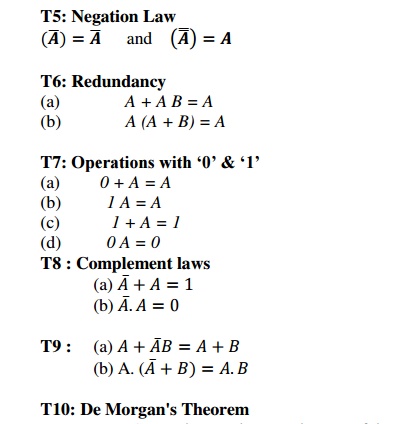
T10: De Morgan's Theorem

Order of Precedence
NOT operations have the highest
precedence, followed by AND operations, followed by OR operations. Brackets can
be used as with other forms of algebra.
e.g. X.Y + Z
and X.(Y + Z) are not the same function.
Truth Tables
Truth tables are a means of representing the results of a
logic function using a table. They are constructed by defining all possible
combinations of the inputs to a function, and then calculating the output for
each combination in turn.
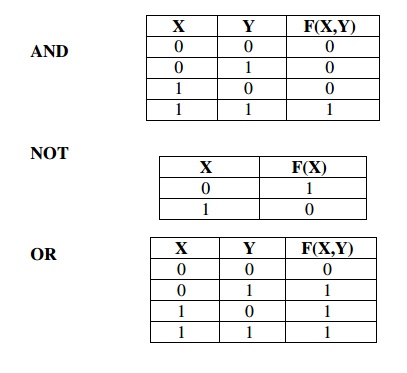
Minterms and maxterms
A binary variable may appear
either in its normal form (x) or in its complement form (x' ). Now
consider two binary variables x and y combined with an AND
operation. Since each variable may appear in either form, there are four
possible combinations: x' y', x'y. xy ' , and xy. Each of these
four AND term s is called a minterm, or a standard
product.
In a similar fashion, n variables
forming g an OR terrn with each variable being primed or Unprimed provide
2" possible combinations called maxterm. or standard
sums.
•
A minterm is the product of N distinct literals
where each literal occurs exactly once.
•
A maxterm is the sum of N distinct literals where
each literal occurs exactly once.
For a two-variable expression, the minterms and maxterms are
as follows
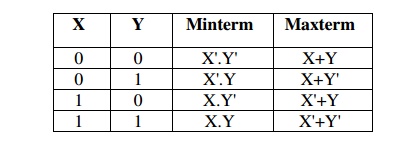
For a three-variable expression, the minterms and maxterms are
as follows
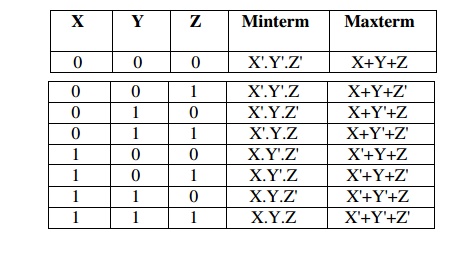
This allows us to represent expressions in either Sum of
Products or Product of Sums forms
Sum Of Products (SOP): F(X, Y,
...) = Sum (ak.mk), where ak is 0 or 1
and mk is a minterm.
To derive the Sum of Products form from a truth table, OR
together all of the minterms which give a value of 1.Consider the truth table
as example,

Here SOP is f(X.Y) = X.Y' + X.Y
Product Of Sum (POS): The
Product of Sums form represents an expression as a product of maxterms.F(X,
Y, .......) = Product (bk + Mk), where bk is 0
or 1 and Mk is a maxterm. To derive the Product of Sums form from a
truth table, AND together all of the maxterms which give a value of 0.Consider
the truth table from the previous example
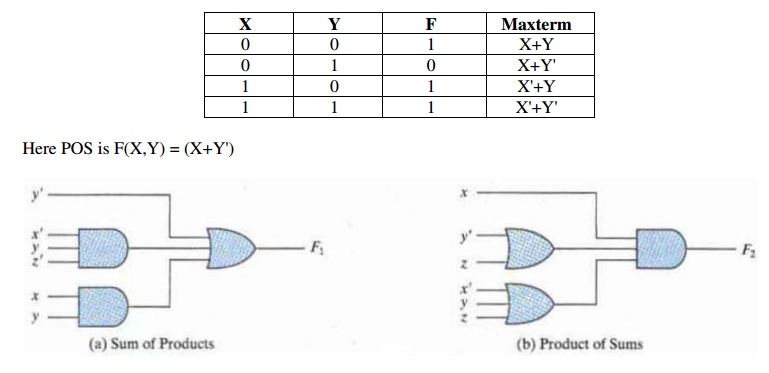
Conversion between POS and SOP: Conversion
between the two forms is done by application of DeMorgans Laws.
Ref: 1) A.P Godse & D.A Godse “Digital Electronics”, Technical publications, Pune, Revised edition, 2008. Pg.No:2.1-2.10
2) Morris Mano M. and Michael D. Ciletti, “Digital Design”, IV Edition, Pearson Education 2008.Pg.No:36-44.
Related Topics